Hot or Cold Foil? – That is the Question.
With the variety of manufacturing options available to add eye catching effects, one of the most talked about is the difference between hot foil and cold foil.
Cold Foil
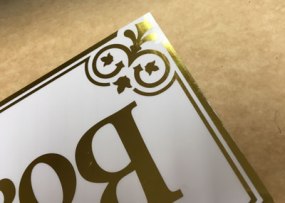
During the cold foil process, a UV-curable adhesive is printed on the substrate in the shape of the design that is to be foiled. The foil is then pressed onto the material and is stripped away where no adhesive was printed. After a quick run under the UV light, the product is finished.
Cold foil runs fast on press and precise registration is able to be achieved. It is available in a wide variety of patterns and colors, and no tooling is required for the process. Cold foil can be overprinted easily and may be utilized on heat sensitive materials. Cold foil is not a replacement for hot stamp, but rather another option for foiling on a package.
Hot Foil
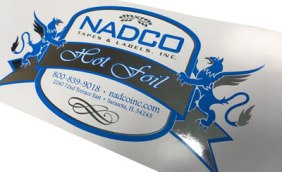 With hot foil stamping, a die of the design to be foiled is mounted above the substrate and is then heated. The hot stamp foil, a metalized PET film with a heat activated adhesive, runs between the die and substrate. When pressure is applied from the die onto the material, the foil is fixed to the substrate’s surface. Because pressure is a main ingredient to hot foiling, the foil has dimension and a distinct feel.
With hot foil stamping, a die of the design to be foiled is mounted above the substrate and is then heated. The hot stamp foil, a metalized PET film with a heat activated adhesive, runs between the die and substrate. When pressure is applied from the die onto the material, the foil is fixed to the substrate’s surface. Because pressure is a main ingredient to hot foiling, the foil has dimension and a distinct feel.
Hot stamp foil delivers a luxuriously rich, raised look. Very fine lines and text can be incorporated into packaging designs, in many different colors and patterns. Hot stamp foil does not require a print station and may be used in conjunction with porous and
uncoated materials.
HOT FOILING
Better quality, brighter.
Hot foiling can be combined with embossing and stamping
to produce a tactile effect. Cold foiling can’t.
You don’t need an ultra-clean environment to hot foil; you do to cold foil.
You don’t experience problems with UV lamps which can be common during cold foiling.
COLD FOILING
Significantly cheaper. Adequate where very high quality isn’t a concern.
In-line foiling means it can be completed after or in between printing processes.
Much quicker process than hot foiling.
Cold foiling also has the appeal of being generally cheaper than hot foiling
which is why we offer both techniques.
Social Responsibility by Charitable Donations
Social responsibility is the idea that businesses should balance profit-making activities with activities that benefit society. A charitable donation is a gift made by an individual or an organization to a nonprofit organization, charity or private foundation.
Nadco’s social responsibility is very well known in our local community. We regularly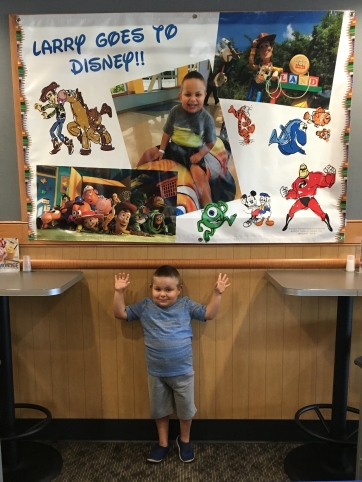 donate our time, products, and services for good causes Usually we don’t hear about how the donated product affected the end user but occasionally we do. Case in point – we were tasked with creating a banner for a Make-A-Wish child on a very short timeline (1 day). The team worked quickly to not only design the banner from scratch but also got it printed and delivered on time.
donate our time, products, and services for good causes Usually we don’t hear about how the donated product affected the end user but occasionally we do. Case in point – we were tasked with creating a banner for a Make-A-Wish child on a very short timeline (1 day). The team worked quickly to not only design the banner from scratch but also got it printed and delivered on time.
The client sent the following: “Our wish party for Larry on Sunday was so much fun! He absolutely LOVED the banner! He just kept looking at it and smiling. He told us he’s going to hang it in his room. I hope you know how special you made his day with your generosity. He leaves for his Disney Wish tomorrow, and he is beyond excited!
~ Thank you again!”
Reading a comment like that makes it all worthwhile.
Stand Back – Blast Tape In Use
BT-100, better known as Blast tape, doesn’t explode but rather the blast refers to media blasting of surfaces – some call it paint stripping. BT-100 prevents small particles of blast media and other foreign debris from infiltrating and damaging sensitive surfaces, components and control systems and protects areas you don’t want blasted.
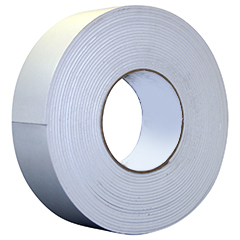 Blast tape has an acrylic adhesive that provides instant adhesion to clean / dry surfaces with little to no hot glue required on edges to prevent media intrusion and clean removal after blasting. Remains flexible and resists cracking and lifting and easily conforms to irregular / curved surfaces. Uniform thickness allows maximum blast times. BT-100 tears easily by hand and can also be cut by knife for precise fit.
Blast tape has an acrylic adhesive that provides instant adhesion to clean / dry surfaces with little to no hot glue required on edges to prevent media intrusion and clean removal after blasting. Remains flexible and resists cracking and lifting and easily conforms to irregular / curved surfaces. Uniform thickness allows maximum blast times. BT-100 tears easily by hand and can also be cut by knife for precise fit.
The next time you need to media blast something, contact us for a roll or three and get protected.
The Origins Of Tape
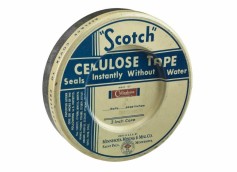 Did you know that the discovery of adhesive tape originated from tree sap? While the first use of tape didn’t appear until 1845, the adhesive substance that is commonly found in many tapes today dates back all the way to 4000 B.C where pots were made with the substance derived from tree sap.
Did you know that the discovery of adhesive tape originated from tree sap? While the first use of tape didn’t appear until 1845, the adhesive substance that is commonly found in many tapes today dates back all the way to 4000 B.C where pots were made with the substance derived from tree sap.
However, it wasn’t until 1925 when the first official tape was invented by a man named Richard Drew. After overhearing several mechanics complaining about the tape they used, Richard experimented for over two years with adhesives and finally created the tape that we know today as “Scotch” tape. As for the reason it was called “Scotch” tape was because back in those days, “scotch” was slang for cheap. Many of the mechanics that Richard had contacted thought that he was very scotch with his tape and so Richard made a bold statement by naming it “Scotch” Tape.
This Month’s Featured Industry- Construction
There is one inevitable activity that occurs every summer. No it’s not the annual vacation or family reunion but rather it is construction. Construction is one of the pioneer industries in the world, constantly improving upon infrastructure to make the world a better place.

As much as construction can hinder our daily commutes & activities, the roads wouldn’t be as safe as they are without the technological advances in the construction industry. The world we live in today is influenced by construction. Many of the materials that we provide at NADCO ® can be seen throughout the world at various construction sites; from small to large-scale construction whether it’s simple construction on the street or a skyscraper.
Let’s Talk Prototyping!
The word prototype derives from the Greek – protos, “first” and typos, “impression”. A prototype is an early sample, model, or release of a product built to test a concept or process or to act as a thing to be replicated or learned from. A prototype is generally used to evaluate a new design or idea. Prototyping serves to provide specifications for a real, working piece rather than a theoretical one. In some design workflow models, creating a prototype (a process sometimes called materialization) is the step between the formalization and the evaluation of an idea.
Many people have contacted Nadco to prototype their idea. During the initial contact, questions are asked such as – Will it be used outdoors, in high heat, extreme cold, or wet environments? What material should be used? What size? The size question usually will dictate how your prototype will be created. Many prototypes were cut to size and shape with a laser, other pieces were created with dies we already have in stock. Using the laser, we can create any unusual shape like an octopus for instance.
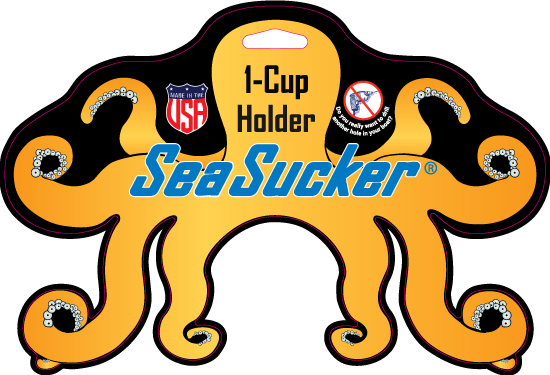
After the material is selected and art provided, or we create it, the prototype is made and sent out. The customer inspects and evaluates the piece. Is the size too big, too small? Is the material too thick, too thin? Quite often the initial questions make the prototyping process much quicker as the piece is usually right on the mark with only minor tweaks needed. The prototype is now refined and ready for actual production. It’s time to put the piece out there and see what kind of “first impression” it makes.
Just keep at it!

Thomas Edison made 1,000 unsuccessful attempts at inventing the light bulb. When a reporter asked, “How did it feel to fail 1,000 times?” Edison replied, “I didn’t fail 1,000 times. The light bulb was an invention with 1,000 steps.”
Henry Ford failed and went broke five times before he succeeded. R. H. Macy failed seven times before his store in New York City caught on. There is a professor at MIT who offers a course on failure. He does that, he says, “because failure is a far more common experience than success.” An interviewer once asked him if anybody ever failed the course on failure. He thought a moment and replied, “No, but there were two incompletes.”
These are a few reasons to just keep at it. Here at Nadco, we keep working with you until your idea/invention/product is realized. Currently we are working on several pieces that started out as an idea with a rough sketch. Very soon these products will hit the market, although we can’t divulge any information about them, Nadco is busy making prototypes to send to the customers for testing. If you think your idea has value, give us a call and talk it over with our sales team.
You may be disappointed if you fail, but you are doomed if you don’t try.
Trade Show Power
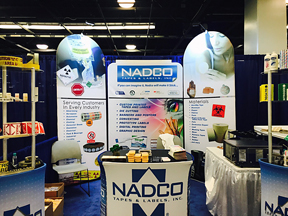 Many companies go to trade shows to find potential new customers or to introduce themselves to a market. Drawing in potential customers to your booth is critical to success. Early in February the NADCO team went to the MD&M West show in California. Our President, Rená, made fresh cookies during the event. Needless to say the smell of fresh cookies drew in many, some coming back a second time for the warm ones. The whole set up was designed to attract attention, the smell of fresh cookies was done to make people stop.
Many companies go to trade shows to find potential new customers or to introduce themselves to a market. Drawing in potential customers to your booth is critical to success. Early in February the NADCO team went to the MD&M West show in California. Our President, Rená, made fresh cookies during the event. Needless to say the smell of fresh cookies drew in many, some coming back a second time for the warm ones. The whole set up was designed to attract attention, the smell of fresh cookies was done to make people stop.
NADCO had a plan for this trade show. We spent months compiling pieces from business cards to backdrops and all of the pieces were branded with our logo, info and fit the theme. All of the design work was done in-house. Other than the backdrop, shelving units and a few pieces, NADCO produced all of the marketing products at our facility. We left nothing to chance, we even produced labels for the cookie and sample bags.
All of the hard work paid off, our phone hasn’t stopped ringing. The next time you decide to go to a trade show, do what you are good at. Nadco just happens to be great at making tapes and labels and apparently, cookies.
Niche Products Are The New Thing
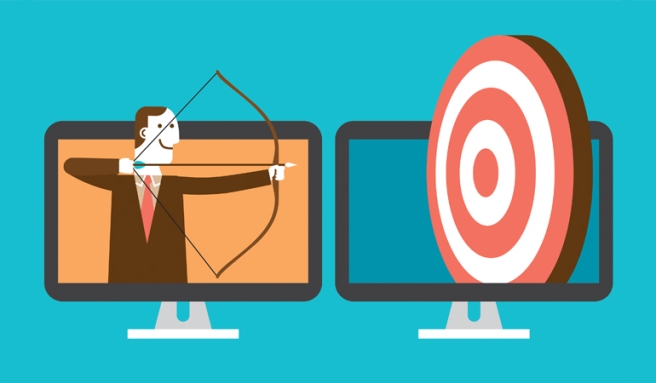 There are so many hip new products now that nobody had heard of before until they were marketed in an ecommerce environment. Physical locations rely on foot traffic and location which definitely shrinks reach. Forward-thinking merchants want to reach a bigger audience to compensate for a smaller target group, ecommerce offers endless opportunities to educate about a new product. Ecommerce is proving to be the best channel for selling niche products. Actually, it might be even easier to cater to a more specific target customer group online – you have better targeting tools and traffic efforts can be really well-focused.
There are so many hip new products now that nobody had heard of before until they were marketed in an ecommerce environment. Physical locations rely on foot traffic and location which definitely shrinks reach. Forward-thinking merchants want to reach a bigger audience to compensate for a smaller target group, ecommerce offers endless opportunities to educate about a new product. Ecommerce is proving to be the best channel for selling niche products. Actually, it might be even easier to cater to a more specific target customer group online – you have better targeting tools and traffic efforts can be really well-focused.
Your brand image plays a key role in determining your success as a niche marketer. The more credible and trustworthy you are, the more chances you have of making sales and commissions. Your brand image is not just what people are saying about it, it’s your labeling too. Which product would you buy? One with a label that is well designed, clean, and professional or one that looks like i t was created by a 4 year old with a box of crayons. That is a bit of a stretch, but in a crowed field of products you want yours to stand out. Nadco designs and creates professional labels for many niche products everyday. Give your product the chance it needs to survive.
So, what are you going to do to strengthen your brand image?
